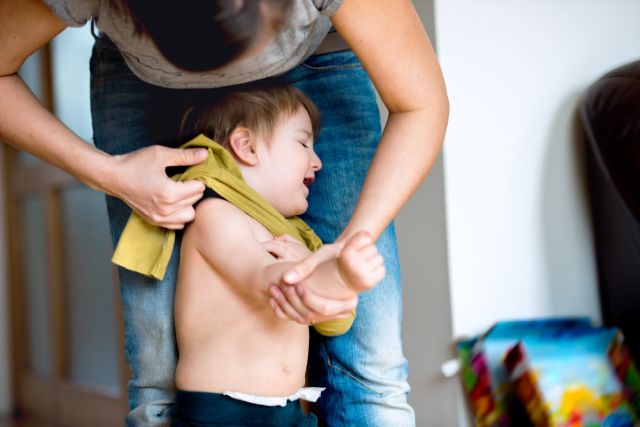General Information
Tactile Sensitivity Explained. My Child Doesn’t Want to Wear Clothes
As Halloween approaches, I start getting questions from parents about the best ways to prepare their sensitive children to wear costumes during halloween. You see, children suffering from sensory challenges often have major sensitivity to various forms of touch.
And that includes the feeling of clothing, fabrics, hats, makeup, etc. that they aren’t used to. Since so many of my clients deal with tactile defensiveness, I thought today would be a good opportunity to talk about children’s hypersensitivity to touch.
In addition, we’ll offer tips on how to help children cope with wearing different types of clothes. And that includes, of course, Halloween costumes!
Topics I’ll Address regarding tactile sensitivity:
Why is it my child overreacts to being touched?
Why is it my child doesn’t want to wear clothes?
What exactly is touch sensitivity, tactile sensitivity, and tactile defensiveness?
Does this mean my child has Sensory Processing Disorder, Autism, Asperger’s Syndrome, or Attention Deficit Hyperactivity Disorder (ADHD)?
How can I help my child learn to cope with wearing different types of clothes?
Why is it my child overreacts to being touched?

If your child has extreme tactile sensitivity, he or she perceives the sensation of touch differently from you. Is your child is over the age of 3 or 4, and dealing with his/her tactile sensory disorder is an everyday struggle? Then it’s important to consider your child being tactile defensive as part of a bigger picture of Sensory Processing Disorder.
What Is Sensory Processing Disorder?
Tactile Sensitivity as a side effect:
There are many medical conditions or developmental disabilities that can present tactile sensitivity as a side effect. Some of these include:
- Sensory Processing Disorder (SPD)
- ADHD or ADD (Attention Deficit Hyperactivity Disorder or Attention Deficit Disorder)
- Autism
- Autism Spectrum Disorder
- Asperger’s Syndrome
- Tourette’s Syndrome
- Trauma, stress and anxiety
- Dyspraxia
- Emotional trauma or dysregulation
- Lead over-exposure
- Forebrain Commissurotomy for the treatment of epilepsy
- Tactile sensation
- Tactile stimuli
However, there are also many children who experience tactile sensitivity without any type of diagnosis. Your child’s sensitivity may be idiopathic (unexplained). The point is not to necessarily panic or label your child as having a problem.
The point is simply to understand the condition as a whole and how you can guide your child’s hypersensitivity to touch toward a more enjoyable life.
Take our Sensory Processing Disorder Quiz to find out how your child’s sensory-motor skills fit on the spectrum.
Sensory Processing Disorder QuizWhy is it my child doesn’t want to wear clothes?

All children eventually find a favourite costume or outfit. There are the girls who love twirly skirts and tutus. Or the boys who want to dress like a cowboy every day.
The favourite character t-shirt or even the worn-out jeans with holes in them that are too small but you can’t coax them to throw away. Or the child that loves to be naked, shirtless, or pants-less.
They just don’t LIKE to be dressed, but eventually gets over it after getting them into their clothes.
These are not the children I’m speaking about.
Genuine pain and/or panic
I’m referring to children who genuinely panic or cry in pain almost every day when it’s time to dress.
I’ve seen so many children with a range of protests about clothing and one in particular was sad to watch. A little girl who took over an hour and a half to get dressed each morning.
Her mother would try to coax and bribe her into outfits. But the daughter would erupt into screams of agony and protest as if she were panicking or in pain.
If your child has tactile defensiveness, it might actually physically hurt to wear certain types of clothing.
An ill-placed seam, an itchy tag, a button that pokes in just the right way. These are examples of common complaints from children I’ve worked with in therapy. Due to their sensory input malfunction, just the sensation of that touch can seem painful to them.
It could also be that your child doesn’t want to wear clothes for specific reasons. It might be because certain lightweight fabrics, ribbons, ties, or skirts are constantly brushing against their skin.
These items may touch in a way so as to trigger their defensiveness over and over every time they move.
For children like the little girl I described, their brain is processing sensations in a different way. It’s impossible for them to relax and get used to it. Their bodies are reacting with Fight or Fright mode. So, their reactions are involuntary at that point.
i hate when my hair touches my face, which may affect your tactile defensive child too.
What exactly is touch sensitivity, tactile sensitivity, and tactile defensiveness?
Let’s clear up some of the technical language we use to help in our understanding and treatment of these types of sensory issues and why your child overreacts to being touched.
There are technically three sub-classifications for the type of reaction someone with this condition has to being touched:
- hypersensitivity,
- hyposensitivity, and
- poor tactile perception/discrimination.
Hypersensitivity means someone is overly sensitive to sensations of touch. They can feel things more strongly than the average person.
So they tend to have a negative reaction, such as withdrawal, avoiding, or escaping, in response to feeling touch. Tactile defensiveness is another word for when your child overreacts to being touched.
Hyposensitivity means someone is under-reactive to the sensation of touch. They don’t feel touch as well as the average person. So they tend to either underreact when bumped (or even injured) or to seek out stronger pressure to satisfy their senses.
Tactile sensitivity is a general term that can refer to either hypersensitivity or hyposensitivity.
Does this mean my child has Sensory Processing Disorder, Autism, Asperger’s Syndrome, or Attention Deficit Hyperactivity Disorder (ADHD)?

Not necessarily!
All children go through a period of learning and interacting with various types of environments. It’s part of their normal socialization routine. And it includes exploring various types of sensations, textures, temperatures, etc.
Sensory exploration games are becoming quite popular with preschool educators. Just type in ‘sensory activities’ in Pinterest to see for yourself!
Throughout their early childhood, the continuum of reactions to their environment fluctuates and changes as new experiences are added.
So, if your child overreacts to being touched, it doesn’t automatically indicate they have a developmental issue. It could simply mean that they haven’t had enough experience to create a memory bank of proper reactions and coping mechanisms.
Depending on how old your child is and what type of environment they’re exposed to regularly, there may be several desensitization stages you can encourage.
Consider consulting a professional:
Of course, consulting a professional in early childhood development is the best way to know for sure what that could look like. Book a consultation with a CoordiKids pediatric occupational therapist
On the other hand, children with Sensory Processing Disorder, autism, Asperger’s Syndrome, and even ADHD do have a higher chance of dealing with tactile sensitivity than children who are not on these spectrums.
So it is important to work with a professional to find out if there is a bigger medical reason behind your child’s tactile meltdowns.
How can I help my child learn to cope with wearing different types of clothes?
Suggestion 1: Keep notes
Create a Detailed Description of Your Child’s Aversions and Reactions. Tactile sensitivity has many presentations, symptoms, and types of reactions: hypersensitivity, hyposensitivity, and generally poor tactile perception.
So it will be important to start observing and making notes about your child’s behaviour to help you have a clear picture of his or her challenges and how to adopt coping strategies.
For example, if your child doesn’t want to wear clothes, finding out that lightweight or wispy fabrics aggravate your child will help you to know to avoid the princess costumes or caped superhero outfits this Halloween. Instead, look for or make costumes with tight-fitting pieces like tights that can work into the costume well.
Suggestion 2: Sensory clothing
Try sensory-sensitive clothing options, like seamless garments, weighted vests or tight-fitting underclothing. Comfort Clothes (USA), Therapro (global), Soft Clothing, Calming Kids (AU) are all examples of shops that specialize in sensory clothing.
Having a closetful of options that don’t aggravate your child’s sensitivities will help your morning routine go more smoothly and will help you have a neutral base with which to work in testing out new options to include more variety, like a costume, later on.
Suggestion 3: Soft and comfortable
Stick with soft, comfortable fabrics. Fleece sweatpants and sweatshirts are favourites for cooler weather needs, so creating a series of outfits and a Halloween costume that use a sweatsuit as the base is a great way to ensure your child’s comfort.
Thanks to the trend of character onesies and pajama sets, you should be able to find some great, soft costume options in the pajama section!
Suggestion 4: Keep it simple
Stay away from accessories and makeup for a while. Tactile sensitive children often have meltdowns related to accessories, so Halloween costumes are particularly difficult for them.
Feeling heavy face paint, a mask rubbing their face, a hat or wig brushing their hair in strange ways…all of these are examples of bad ideas this Halloween if you want to avoid problems with your sensitive child. Masks can always be mounted on a stick so that he/she doesn’t have to wear it but can keep with the festivities!
Suggestions 5: Small steps
Do a low-stress, short-term test run of everything! Introduce a new clothing or costume item a few different times over a short period of time when your child is comfortable and relaxed. For example, a quiet Saturday morning at home is a great time to try a new outfit item for 30 minutes.
Make sure your child’s sensory sensitivity to clothing choice passes the test a couple of times before they wear it all night at a sensory-overloaded Halloween party or trick-or-treating session. And don’t wash the costume after the trials!
It will change the texture and even the residue of soap or fabric softener can irritate the sensitive child.
For a whole list of tips to enjoy Halloween with a sensory sensitive child, read our article Is Your Child Scared of Halloween? Halloween Tips for the Highly Sensitive Child:
Of course, not everything can be prepared for. Parents, it’s important for you to remind yourself to relax and have fun too.
Don’t get so caught up with protecting your child from everything that you forget to have fun on this great holiday. Your child will pick up on your stress signals otherwise!
Are the activities enjoyable?
If you find that you are no longer enjoying activities like Halloween, other holidays, or parties in general with your family, consider this. You should consider setting up a consultation with a child development specialist.
Perhaps there is more to your child’s sensitivity to the environment than you previously thought. Marga offer consultations to discuss with you the stress you’re dealing with in trying to help your child be comfortable on a daily basis.
Set up a consultation with Marga or another pediatric occupational therapist. Because having someone who’s seen a wide range of childhood behaviours might be what you need to feel and cope better!
No matter what, there are plenty of resources, exercises, and programs that are simple and fun. And you can use these with your children year-round.
These can be used to help them learn to cope with a stressful environment, adapt to change, and recuperate from a meltdown.
One way is through our series of at-home therapeutic motor skills activities called Home Courses. See how it can help your little one.
Happy Halloween!
Some kids will gravitate toward gooey and sticky instead of avoiding it. You can create sensory bins for your child to play with. Fill a small plastic bin with things like sand, rice, beans, shaving cream, or water, and add small toys. It can help contain the mess while meeting your child’s sensory needs.
Another hint is to look for actual clothing pieces at a thrift store instead of the cbaracter costumes. The fabric and fasteners (usually cheap velcro) and poor fit in most Halloween costumes can really trigger sensitivity.